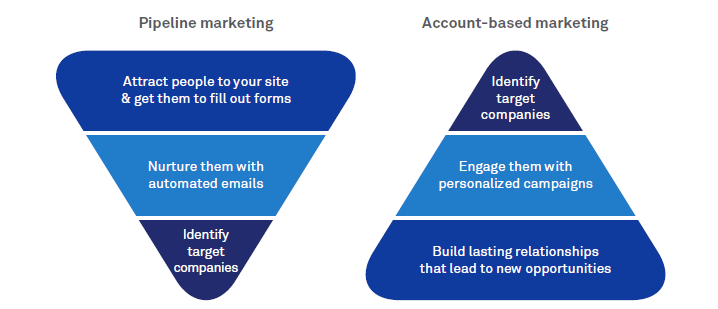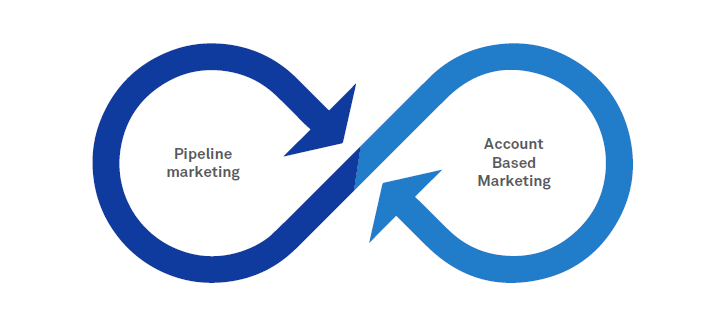The science of Marketing has invested decades in developing and polishing three core practices to promote products and services (business)—Inbound Marketing, Pipeline Marketing and Account Based Marketing (ABM) have become the cornerstones of systematic marketing. But could there be a fourth approach that rises above existingpractices to deliver better results? The short answer to the question: Yes, there is! This new
and highly effective approach makes your marketing dollar work harder and delivers better outcomes. However, to appreciate this approach, it helps to put it in the context of current practices.
The world of marketing as we know it
Inbound marketing is focused around creating interest in a business. Simply put, you provide content, you sign up influencers, set up events and create memorable experiences for customers. If these are relevant and appealing, customers will come knocking at your door. They will arrive at your office, retail outlet, market place, website, blog or will download your mobile app, etc. These become `leads’. The traditional focus of Inbound marketing, more often than not, is lead generation than conversion. It is the marketing team’s job tosegment the leads, study their needs, and then create engaging and valuable content to gain their trust. Finally, it is time to convert them with the right price point, SKU, offer, discount or deal. As simple as it sounds, Inbound gives marketing professionals sleepless nights because it does not always produce the target results that businesses want.
Pipeline marketing is a progressively evolved approach. It is meant to fix some of the limitations that Inbound has. Pipeline marketing generates leads, but with a difference: There is agreement on how marketing will be measured on the quality and conversion of the leads. Marketing Qualified Leads (MQL) must demonstrate certain minimum criteria to filter and prioritize leads from well-defined target segments. These are further scored and qualified using a number of techniques such as BANT (Budget, Authority, Needs, Timeline) scores and persona-matching to be nurtured and turned into Sales Accepted Leads (SAL) that sales can target without waste. And finally, with multi-touch nurture campaigns, these are converted to Sales Qualified Leads (SQL) which either result in a sale or they (unfortunately!) don’t. Notice that sales and marketing have aligned goals and it is also possible to measure the effectiveness of marketing tactics by examining the metrics for the complete funnel, from MQL to SQL. Pipeline marketing delivers better results because both sales and marketing teams focus on lead conversion with common attribution.
Account Based Marketing (ABM) is a highly effective strategy for growing wallet share among target customers when there is clarity of potential targets. ABM is a sort of flipped funnel of Pipeline Marketing, starting with a handful of ideal customer profiles, which are identified through a set of parameters such as firmographics, technographic, demographics and environment. These profiles or accounts are then nurtured with personalized engagement in a bid to establish a long-term relationship. Once the relationship is cemented, it can be expanded to target the account for cross-sell and upsell, and also turn the account/ customer into a brand advocate. ABM ensures that marketing and sales KPIs are aligned and both teams work toward the same outcomes. However, ABM calls for focused investments in both sales and marketing to build an account relationship, and can also consume management bandwidth, which may also be taxing at times.
The critical difference between the Pipeline marketing approach and the ABM approach is that the former is like casting a fishing net where the quantity of the ‘catch’ is large; while the latter is a land-and-expand technique where the quality and relationship with the account/ customer matters. At the intersection of the two (that is, the Pipeline + ABM approach) emerges the new marketing paradigm to create a holistic and powerful approach.

Fig 1: Flipping the funnel with Account Based Marketing
Getting the best of both worlds
When an organization has a need to nurture and grow strategic, enterprise, high-touch customers with a special focus, ABM works well. However, increasingly, organizations need to combine the power of Pipeline marketing with the finesse of ABM to deliver results. They may often need the best of both worlds in multiple situations, viz.

Fig 2: A holistic approach for futuristic marketing organizations
There are several instances when organizations can leverage synchronous interaction between Pipeline and ABM. Once the leads are analyzed for new customers and the potential target set is narrowed down using the Pipeline approach, the resulting targets can be fed to ABM, which can then nurture and grow them.
The reverse also creates exciting possibilities. AMB is capable of generating powerful, referenceable customers (a result of the careful nurturing). These customers can become advocates and generate fresh client references. These references can be further leveraged into Pipeline marketing to expand the population of new prospects and better conversion.
By leveraging the best of both worlds, the outcomes are easier to predict and can also be controlled more precisely for:
Critical success factors
Fortunately, the approach does not require new learning. The elements of Pipeline marketing and ABM are well-known. But the success in combining the two requires an astute approach where realistic expectations are first set at an organizational level while, simultaneously, marketing and sales teams are brought into closer alignment. The short but important list of success factors would include:
The strategy should be to set small targets, learn from them and evolve. The two teams must be able to collaborate with similar goals in mind.
For example, when a customer is browsing a website, the marketing function should be able to quickly send the right content to the customer and alert the sales team with details that make it easy for them to reach out to the customer in real time. In other words, customer focus must be turned into a tight, well-choreographed routine between the two teams.
The intersection between Pipeline and ABM will create new roles, requirements and processes. The organization must be prepared to take an evolving approach to change management, to extract maximum ROI from the mixed marketing strategy, combining it with a KPI focus that measures and optimizes investments, resources and campaign strategy.
Using data and technology to make it easier
However, it all starts with the marketing function that must use a data-driven approach with advanced technology and self-learning models to provide contextual customer experience. The Pipeline + ABM approach also benefits from the use of technology such as the SaaS-oriented Oracle Eloqua, Bluekai Maximizer, Infinity, etc., that enable lead generation, qualification, conversion and use intelligent data-driven processes for campaign management. These technologies are meant for B2B and B2C marketing across channels, networks and devices with coherent attribution. An additional layer of Artificial Intelligence (AI) can also deliver exponential results by refining personalization and creating contextual engagement (for example, by deploying conversational or augmented AI) based on models, machine learning, analytics and algorithms. To sum up, the top key enablerswould be:
The old-school ways of marketing using intuition, luck and “it-has-worked-before” logic are over. The new marketing tool kit is becoming sophisticated, data-driven, technology-intensive and measurable. The advanced methodologies, resulting from a combination of Pipeline and ABM techniques, are able to generate larger and high-quality customer pools, improve targeting, track campaign performance in real time, improve predictability, measure outcomes and realize better ROI.
Fundamentally, the combination of the two is able to deliver the results that tomorrow’s target-driven marketing teams demand. No business can ignore this as it could mean the difference between additional business and lost opportunities.
Anand Savla
Global Strategy Head - Modern Application Services, Wipro Limited.
Anand Savla is the Global Strategy Head for Modern Application Services. With over 20 years of diverse industry experience across Strategy, Consulting, Delivery, Operations and Presales, he is currently responsible for steering Wipro’s strategy and M&A for Enterprise Applications, improving market positioning and nurturing Digital Marketing. He has been instrumental in driving success for customers’ large CX transformation initiatives. Anand holds a Bachelor’s degree in EEE from BITS, Pilani and an MBA from IIT Delhi.